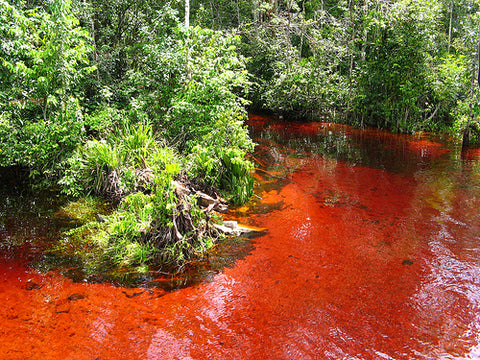Tannin Aquatics
CCA Members
Editor's note- I was contacted by today's guest author, Vince Dollar, some weeks ago, after he stumbled on the Tannin Aquatics website. Intrigued by our offerings and ideas, he proferred that there is way more to the concept of "aquatic botanicals" than just great-looking aquariums! A very enthusiastic, experienced aquarist, Vince is as into the "tinted" aquarium concept as I am.
However, his intellectual curiosity led him even further, beyond the simple aesthetics, to research the more "practical" aspects of botanical-influenced aquariums- specifically, their production of humic substances and the benefits they offer aquarium fishes. His research and personal experiments have led to some remarkable findings and conclusions that, in our opinion, will change the way we think of our aquarium water composition and its impact on our fishes' health and well being. Enjoy!
Humic Substances in Freshwater Aquariums
By Vince Dollar (aka Kmuda)
All natural bodies of water contain dissolved organic carbon (DOC), with 40% to 80% of DOC being comprised of Humic Substances. Humic substances are, in turn, comprised of humic and fluvic acids, both of which are produced by the biodegradation of dead organic matter.
Humic substances are introduced into lakes, rivers, and streams by leaves and wood falling into these bodies of water, forming the “leaf litter” substrate that all Apisto enthusiasts are familiar with, and by rain runoff flowing across the forest/jungle floor, where dead leaves and wood are plentiful. As the water runs across the forest floor, dead and decaying organic matter release tannins. These tannins, which stain the water a tea color, contain humic substances.

A tannin-laden South American Jungle Stream
Up until the last decade, science considered any influence of humic substances on aquatic life as “anecdotal”. Research conducted within the last 10 years has proven that humic substances have an important direct physiological influence on aquatic life. In extreme blackwater conditions, they are what make it possible for fish to survive in pH as low as 3.9. (click to read more)
However, his intellectual curiosity led him even further, beyond the simple aesthetics, to research the more "practical" aspects of botanical-influenced aquariums- specifically, their production of humic substances and the benefits they offer aquarium fishes. His research and personal experiments have led to some remarkable findings and conclusions that, in our opinion, will change the way we think of our aquarium water composition and its impact on our fishes' health and well being. Enjoy!
Humic Substances in Freshwater Aquariums
By Vince Dollar (aka Kmuda)
All natural bodies of water contain dissolved organic carbon (DOC), with 40% to 80% of DOC being comprised of Humic Substances. Humic substances are, in turn, comprised of humic and fluvic acids, both of which are produced by the biodegradation of dead organic matter.
Humic substances are introduced into lakes, rivers, and streams by leaves and wood falling into these bodies of water, forming the “leaf litter” substrate that all Apisto enthusiasts are familiar with, and by rain runoff flowing across the forest/jungle floor, where dead leaves and wood are plentiful. As the water runs across the forest floor, dead and decaying organic matter release tannins. These tannins, which stain the water a tea color, contain humic substances.

A tannin-laden South American Jungle Stream
Up until the last decade, science considered any influence of humic substances on aquatic life as “anecdotal”. Research conducted within the last 10 years has proven that humic substances have an important direct physiological influence on aquatic life. In extreme blackwater conditions, they are what make it possible for fish to survive in pH as low as 3.9. (click to read more)


